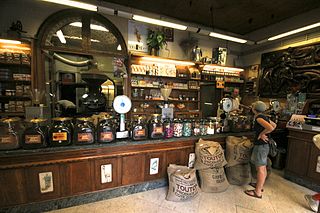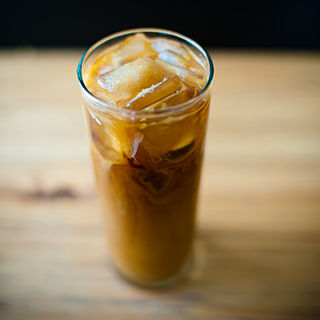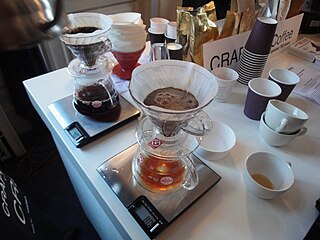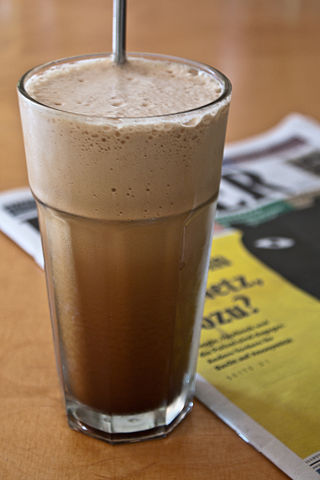Related Research Articles

Cappuccino is an espresso-based coffee drink that is traditionally prepared with steamed milk including a layer of milk foam.

Espresso is a coffee-brewing method in which a small amount of nearly boiling water is forced under pressure through finely ground coffee beans.

Italians are well known for their special attention to the preparation, the selection of the blends, and the use of accessories when creating many types of coffees. Many of the types of coffee preparation known today also have their roots here. The main coffee port in Italy is Trieste where there is also a lot of coffee processing industry. Italian coffee consumption, often espresso, is highest in the city of Trieste, with an average of 1500 cups of coffee per person per year. That is about twice as much as is usually drunk in Italy.

Caffè latte, often shortened to just latte in English, is a coffee drink of Italian origin made with espresso and steamed milk, traditionally served in a glass. Variants include the chocolate-flavored mocha or replacing the coffee with another beverage base such as masala chai, mate, matcha, turmeric or rooibos; alternatives to milk, such as soy milk, almond milk or oat milk, are also used.

Caffè macchiato, sometimes called espresso macchiato, is an espresso coffee drink with a small amount of milk, usually foamed. In Italian, macchiato means 'stained' or 'spotted', so the literal translation of caffè macchiato is 'stained coffee' or 'marked coffee'.

Café au lait is coffee with hot milk added. It differs from white coffee, which is coffee with cold milk or other whiteners added.

An ice cream float or ice cream soda, also known as a spider in Australia and New Zealand, is a chilled beverage that consists of ice cream in either a soft drink or a mixture of flavored syrup and carbonated water.

Iced coffee is a coffee beverage served cold. It may be prepared either by brewing coffee normally and then serving it over ice or in cold milk or by brewing the coffee cold. In hot brewing, sweeteners and flavoring may be added before cooling, as they dissolve faster. Iced coffee can also be sweetened with pre-dissolved sugar in water.

A caffè mocha, also called mocaccino, is a chocolate-flavoured warm beverage that is a variant of a caffè latte, commonly served in a glass rather than a mug. Other commonly used spellings are mochaccino and also mochachino. The name is derived from the city of Mokha, Taiz Governorate, Yemen, which was one of the centres of early coffee trade. Like latte, the name is commonly shortened to just mocha.

A flat white is a coffee drink consisting of espresso and steamed milk. It generally has a higher proportion of espresso to milk than a caffè latte, and lacks the thick layer of foam in a cappuccino. While the origin of the flat white is unclear, various café owners in Australia and New Zealand claim its invention.

A Baby Guinness is a shooter, a style of cocktail, or mixed alcoholic beverage, intended to be consumed in one shot. A Baby Guinness does not contain Guinness stout. Its name is derived from the fact that it is made in such a way as to look like a tiny glass of stout.

Coffee preparation is the process of turning coffee beans into liquid coffee. While the particular steps vary with the type of coffee and with the raw materials, the process includes four basic steps: raw coffee beans must be roasted, the roasted coffee beans must then be ground, and the ground coffee must then be mixed with hot or cold water for a specific time (brewed), the liquid coffee extraction must be separated from the used grounds, and finally, if desired, the extracted coffee is combined with other elements of the desired beverage, such as sweeteners, dairy products, dairy alternatives, or toppings.

Milk coffee is a category of coffee-based drinks made with milk. Johan Nieuhof, the Dutch ambassador to China, is credited as the first person to drink coffee with milk when he experimented with it around 1660.

An affogato, known in full in Italian as (gelato) affogato al caffè, is an Italian dessert comprising a scoop of plain milk-flavored or vanilla gelato or ice cream topped with hot espresso. Some variations add a shot of amaretto, bicerin, Kahlúa, or other liqueur.

A frappé coffee, cold coffee, Greek frappé, or just frappé is a Greek iced coffee drink generally made from spray-dried instant coffee, water, sugar, and milk. The word is often written frappe. The frappé was invented in 1957 in Thessaloniki through experimentation by Dimitris Vakondios, a Nescafe representative. Frappés are among the most popular forms of coffee in Greece and Cyprus and have become a hallmark of postwar outdoor Greek coffee culture.
A sidecar is a one-wheeled device attached to the side of a motorcycle, scooter, or bicycle. Sidecar may also refer to:
The 2010s in food in the United States describes food trends that are characteristic of the 2010s decade. Many of the trends are a direct result of related social or economic events.
References
- ↑ Murphy, Kate (2016-08-04). "How Do Texans Beat the Heat? With Water From Mexico". The New York Times. ISSN 0362-4331 . Retrieved 2022-12-15.
- ↑ Hansberger, Angela. "Try Spiller Park's tasty alternative to a pumpkin spice latte". Restaurant News (The Atlanta Journal-Constitution). Retrieved 2022-12-15.
- ↑ Eschman, Chad (2016-09-26). "The Mixer You Need To Know". VinePair. Retrieved 2022-12-15.
- ↑ Spicer, Maggie (2018-07-15). "Edible Asks: The Origin of the Espresso Sidecar". Edible San Francisco. Retrieved 2022-12-15.
- ↑ Fillari, Giovanni. "Opinion: Iced Coffee Is A Scam, And Hot Coffee Is The Drink Of Summer". sprudge.com. Retrieved 2022-12-15.
- ↑ "Mike Sutter's top 10 best coffee shops in San Antonio". 23 March 2022.
- ↑ Verive, John (2016-10-31). "Everything you need to know about the new Starbucks beer and coffee drink, including where to find it". Los Angeles Times. Retrieved 2022-12-15.
- ↑ "Classic Cocktails in History: the Sidecar". Alcohol Professor. 5 March 2015. Retrieved 2022-12-15.
- ↑ "Espresso martinis are the buzzy 1980s cocktail making a major comeback at Chicago bars". Chicago Tribune. 11 February 2022. Retrieved 2022-12-15.
- ↑ Channing, Cornelia (22 May 2020). "Why do Diners Give You Leftover Milkshake in That Metal Container?". Slate.
- ↑ "Cleanse, Sip, Repeat – Understanding the Espresso Sidecar". Bigcupofcoffee.com. 2023-06-27. Retrieved 2024-06-25.